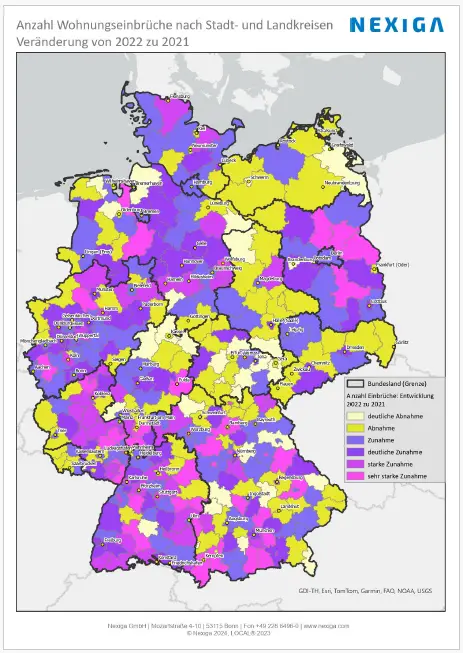The coronavirus times have been tough for all of us, whether as private citizens or for business owners, restaurateurs, cultural workers and many others. But lockdown and other measures to combat the pandemic have also been "tough" for another group. We are talking about burglars.
Due to travel restrictions and lockdown measures, which ensured that many more people were at home, the number of domestic burglaries fell sharply during the coronavirus period in 2020 and 2021.
The "burglary industry" is now recovering. Nationwide, the number of burglaries rose to 65,902 in 2022, which is 11,674 and therefore 21.5% more than in the coronavirus year 2021. The figures for 2023 as a whole are not yet available, but the trend is unbroken. In North Rhine-Westphalia alone, around 28% more domestic burglaries were registered in the first half of 2023 than in the same period last year. This is according to figures from the NRW State Criminal Police Office. Greater security is therefore once again a top priority for homeowners.

Focus on major cities
The number of burglaries increased the most from 2021 to 2022 in the federal states of Baden-Württemberg (+ 36.7%), Rhineland-Palatinate ( + 34.2%) and Brandenburg ( + 34.1%), while in most other federal states the increase was + 10% to + 26%. Three states bucked the trend, namely Thuringia (- 13.8%), Mecklenburg-Western Pomerania (- 13.2%) and Saarland (- 3.6%).
Based on the 400 urban and rural districts, it shows the percentage change between the two annual totals for 2021 and 2022. In a year-on-year comparison, the range extends from a tripling of offenses in the district of Neustadt/Aisch to a decrease of two thirds in Greiz or Suhl. In the major cities, there are mostly strong increases: Cologne (+51.6%), Munich (+30.3%), Berlin (+23.5%). Only in Hamburg (+13.7%) is the increase moderate. So much for the relative comparison.
Winter months particularly volatile
The absolute frequency of domestic burglaries varies greatly in Germany. More burglaries tend to be recorded in urban areas with a high population density than in rural areas. Cities with higher burglary rates can be more attractive for criminal activity due to their size, anonymity, infrastructure and economic dynamism. Transport links also play an important role, especially for organized criminal groups from abroad.
More burglaries are reported in the winter months of December and January in particular. The early darkness in the evening hours offers perpetrators more opportunities to remain undetected. Vacation periods such as summer or Christmas vacations can also be times of increased burglary activity.
The aspects that contribute to an increased risk are manifold. These include - depending on the situation - single-family homes with larger properties with poor visibility or residential areas with a generally high crime rate. Senior households are also at risk as potential easy victims, as are homes that are deserted during the day due to work.
Above all, however, houses and apartments without adequate security measures attract burglars. Implementing preventive measures such as security-conscious behavior, investing in secure windows and doors and mutual attention among neighbors reduces the risk of becoming a victim of burglary. And then there are the police, who can contribute to security with their overt or covert presence, effective investigations and reconnaissance.
More market data with the characteristic crime can be found in our database search.

